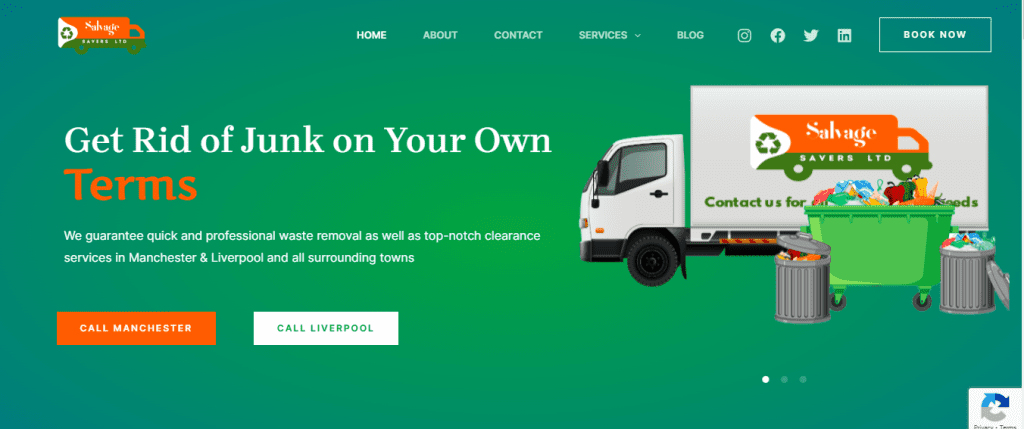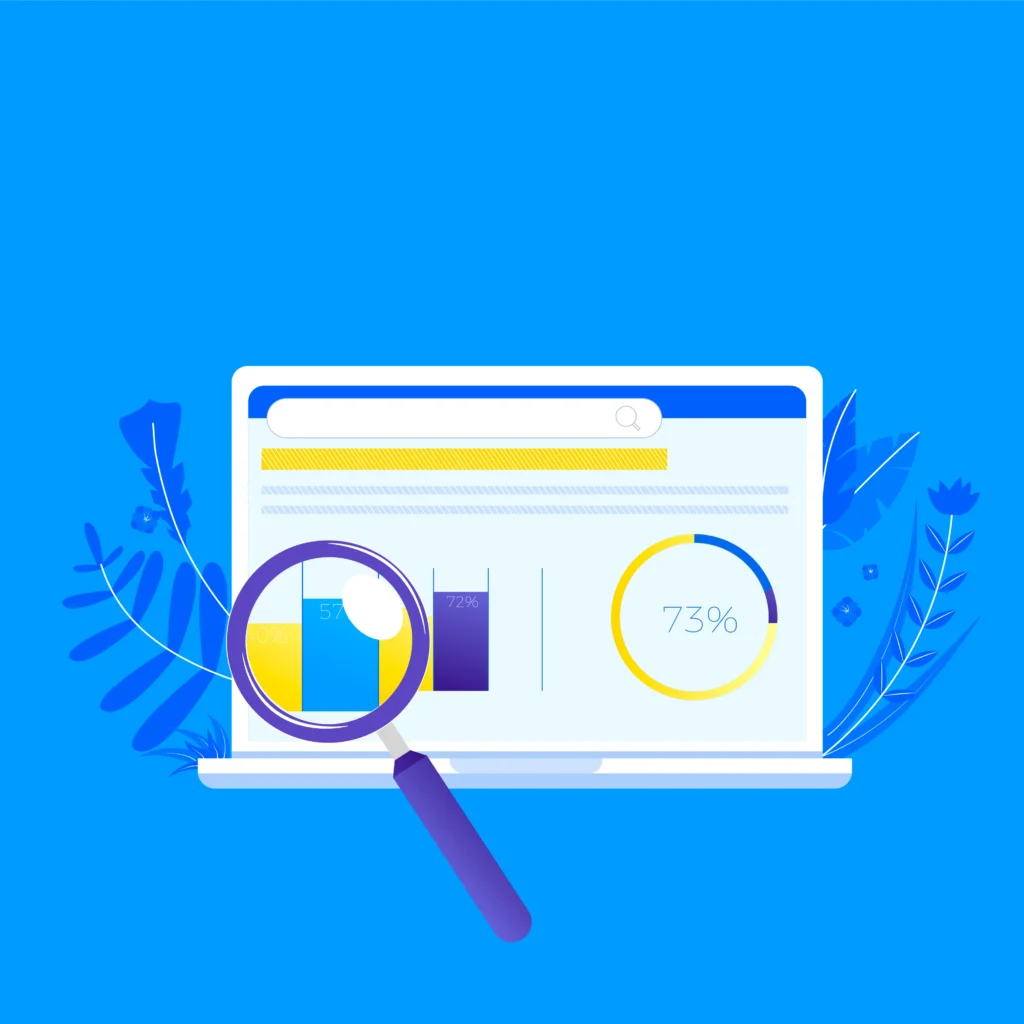This is a Digital Marketing case study on Salvage Savers.
This company is a UK-based startup that provides rubbish removal services for all individuals in apartments, homeowners, and offices in Manchester, Liverpool, Preston, Leeds, Sheffield, Warrington, and all towns in the Northwest of England. They are a fully licensed on-demand removal service company.
The client needed to create more awareness of his brand, while also converting some of the traffic on his website. Because it is a new company in a dominated industry, it was important to help the client’s business gain more authority in the Google Search space, both organically and through paid ads.
It was also important for the client to differentiate his brand from other businesses in the industry and that’s what we sought to do. Therefore here is a list of things Digital Reach Consult did for the client:
- Created a Website
- Started SEO
- Created a PPC campaign with a focus on conversions.
Website
Our client had no website and therefore had not built any authority in the junk removal field. We, therefore, had to begin from scratch. We designed an intuitive and SEO-centered website with all the information his target may need.
The first thing we needed to do was come up with keywords. These are terms that potential clients may use when searching for any product or service the client provides.

SEO
Keywords
The client provides five main clearance services (Home, Office, Loft, Garden, Garage) alongside other minor or single-item removals. Therefore, we needed to create different categories of keywords for each of these services. We ran keyword analysis to funnel out only the best-performing keywords for each category.

SEO is more than just knowing the keywords you need to use, but also how to incorporate them into the website. The next thing was to implement these keywords. One of the best ways of improving SEO and establishing authority is to write articles. Thus, our in-house copywriters collaborated with the client to come up with articles that were not only rich in these keywords but also answered questions that his potential clients may have.
Blog Articles
The website now has 44 blog articles, helping improve organic search rankings and overall SEO. SEO is a long-term project; it doesn’t happen over time. However, with the right personnel and strategy, you can speed up the process.

With effort, we were able to get the client to rank 2nd on the first page for some of the keywords. Overall, the website ranks in the first 5 Google SERPs (Search Engine Result Page) pages.
Over the course of 6 months, our client has gained a total of 11.4K impressions organically on Google search results. Given that SEO is a long-term project, and ranking anywhere between the 1st to 10th page of Google SERPs could take between 12 to 24 months, this number is particularly impressive.
Pay-per-click Ads
Strategy
We also ran a Google Ads campaign for the client in Manchester and Liverpool. We created 2 different campaigns for each of these locations. We did an A/B Split testing to determine between “Maximize Conversions” and “Target CPA”, which strategy would work best for the client. Per the testing, decided to use the “Maximize Conversions” strategy for both campaigns. This is because the client also needed people to take action when they entered his website (i.e. to book a clearance service online or call for enquiry).
Ad Groups
For each of these campaigns, we created 5 different ad groups based on the five main services provided by the client. This would allow us to focus on each of the services in detail and create specific ads for each of the services.
Keyword Planning
With the Keyword Planner and other keyword tools, we came up with 331 keywords across all ad groups, and what keyword match type (phrase, exact or broad match) would maximize the client’s cost.
We went with phrase match for most of the keywords to funnel out individuals looking for the client’s service. We also added 53 negative keywords per client recommendations as well as analyzing keywords that were triggering the ads but not looking for the exact service the client offered.

For example, Bulky Bob is a free council removal service that operates in the client’s country. However, when people would search for Bulky bob, our client’s ads would appear in the search results. To combat this, we added Bulky Bob” and “free” as negative keywords to exclude the client’s website from appearing for those queries.
Daily Budget & Ads Creation
We set a daily budget of £15 for each campaign, as per recommendations from the client.
From there, we needed to create ads for each ad group. We developed three ads for each of these ad groups, focusing on the quality score of each of them. These ads included relevant keywords that made up both the headings and descriptions.
We created text (now responsive ads) and call ads for each ad group. Each ad contained ad extensions to improve the quality score of the ads and also help potential clients have important information just a click away.

After a few months, we noticed the client was getting more conversions from the call ads so we shifted our attention to that and created more call ads for each ad group.
Results
These quality ads we made were shown to clients when any of our keywords were found in our search terms.
Over the span of one year, our ads yielded over 86,200 impressions and 1600 clicks, with an average cost of £2.96 per click. Based on the returns, the client was happy to spend that amount.
Therefore, with both organic and paid results, we had over 97.4k impressions in a span of 6 months, which is an incredible feat, given the client had no online presence, to begin with.
ROI (Return on Investment)
The return on investment on this campaign was measured at 287% or a ratio of 1:2.9. Return on investment is what returns you gain out of your ads and free product listings compared to how much you’ve spent on them. To calculate ROI, take the revenue that resulted from your ads and listings, subtract your cost of goods/service to get your net profit, and then divide by your overall ad spend: ROI = (Revenue – Cost of services) / Ad spend x 100.
How we measured
Sometimes, clients may not be forthcoming with net profit figures and thus, can make ROI calculations tiresome and impossible. We, in practice, have to rely on the revenue generated from the ads instead of profits, which most clients don’t mind sharing.
So to calculate ROI for this client, we used the revenue as reported by the client, and divided it by the total cost of ads:
ROI = (Revenue) / Cost of ads x 100
In total, our ads generated 190 leads, out of which 72 were converted.


Our client reported that the total revenue was £10,800 from the 72 leads that converted. The total cost for all the ads we ran was £3762.06. This, therefore, sets the ROI at 287%, or at a ratio of 1:2.9. Not to toot our own horns, but this is an impressive ROI for the client, seeing that they had no previous online presence. and they were happy to spend £3762.06 on the ads.
Overall, the client was happy with the progress we made over the 5 months and is optimistic for even better in the months ahead. These numbers don’t happen overnight, and without the right person or company heading your digital marketing campaign, it may take a downhill turn.
If you’re looking to start a digital marketing campaign but want a competent manager, Digital Reach Consult houses the best of the best Digital marketing managers in the world. Do not hesitate to give us a call or send us an email.






